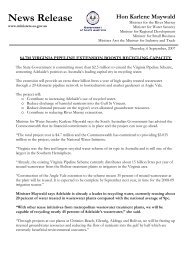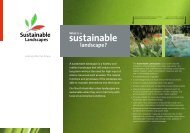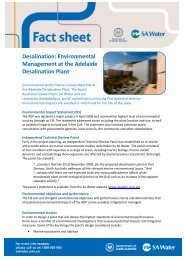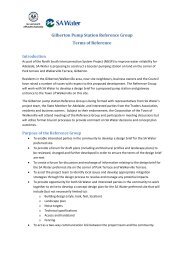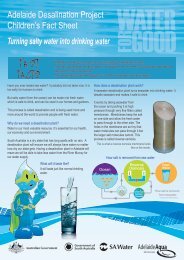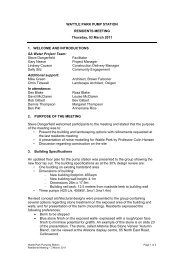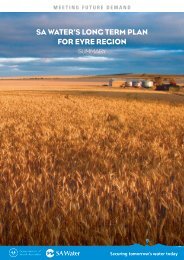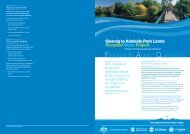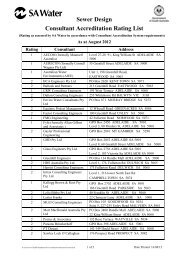Code of Practice - Irrigated Public Open Space - SA Water
Code of Practice - Irrigated Public Open Space - SA Water
Code of Practice - Irrigated Public Open Space - SA Water
You also want an ePaper? Increase the reach of your titles
YUMPU automatically turns print PDFs into web optimized ePapers that Google loves.
7.0 DROUGHT RESPONSE PLAN<br />
A drought response plan should be developed to ensure<br />
strategies are in place to deal with drought scenarios where<br />
water availability for irrigated public open space is reduced.<br />
The objective <strong>of</strong> the drought response plan is to provide a<br />
staged strategy that protects community assets and valuable<br />
recreation facilities while reducing water consumption<br />
during periods <strong>of</strong> drought. The costs <strong>of</strong> re-establishing the<br />
landscape and irrigated turf can be significant.<br />
As a result <strong>of</strong> drought conditions and water shortages in<br />
national capitals across Australia, water restrictions have<br />
been introduced ranging from permanent water<br />
conservation measures where management <strong>of</strong> IPOS must<br />
follow best practice management to Level 5 restrictions<br />
where irrigation <strong>of</strong> public open space using potable mains<br />
water is prohibited. Organisations responsible for managing<br />
IPOS must be prepared to take appropriate action to<br />
comply with water use reduction regimes and restrictions.<br />
In developing a drought response plan the following issues<br />
require consideration:<br />
• A <strong>Water</strong> Efficiency Management Plan (WEMP) should<br />
be developed in accordance with the <strong>Code</strong> <strong>of</strong> <strong>Practice</strong>.<br />
The WEMP should be implemented as part <strong>of</strong><br />
permanent water conservation measures.<br />
• All irrigated sites should be categorised according to the<br />
TQVS standard and functional objective <strong>of</strong> the site as<br />
part <strong>of</strong> the WEMP.<br />
• An inventory <strong>of</strong> all significant and feature trees and<br />
garden beds should be made prioritising them in order<br />
<strong>of</strong> importance.<br />
• Turf sites should be assessed against functional standards<br />
and reduced in size to the minimum area required to<br />
meet the functional objective. Areas where irrigation is<br />
withdrawn should be re-landscaped with drought tolerant<br />
plantings and treatments.<br />
• A strategy <strong>of</strong> withdrawing irrigation from less functional<br />
sites should be prepared, to be implemented as water<br />
availability decreases.<br />
• Alternate water supplies to potable mains water should<br />
be investigated and where possible accessed for irrigation<br />
purposes. Ground water or recycled water may have to be<br />
transported to critical areas <strong>of</strong> the landscape i.e.<br />
significant trees or turf cricket pitches, as mains water<br />
availability reduces.<br />
• Sports grounds may have to be closed to competitive<br />
sport where grounds become unsafe for play. Turf quality<br />
and risk assessment audits will form the basis <strong>of</strong> such<br />
ground closures.<br />
34



